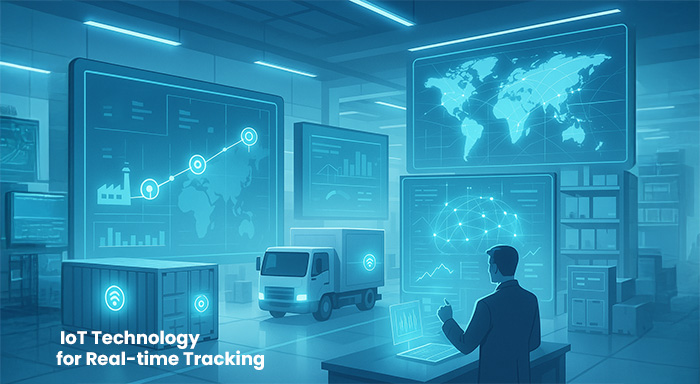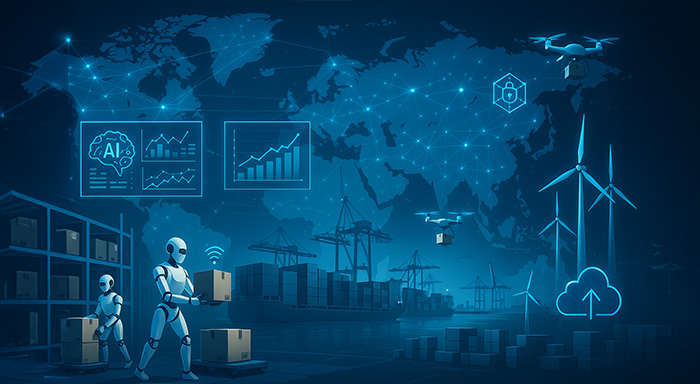The worldwide supply chain often seems like an intricate web of complex processes rather than an efficient system. Common problems such as inefficiencies, delays, or lack of overall visibility exist everywhere, frustrating businesses. But does it sound familiar? Numerous businesses are juggling through various tasks while keeping up with evolving e-commerce requirements and intricate logistics. However, things are not as bleak as it seems because technology is there to help and redefine the way supply chain management operations take place.
Are you aware of the fact that approximately 60% of the organizations strive to adapt AI in their processes as soon as next year? This transition is expected to render more quicker deliveries, more proactive and intelligent planning, and less hassle for businesses such as yours. In this article, let us explore how platforms such as IoT, AI, blockchain, and robots can address such issues. You will understand how technological developments make logistics a lot simpler while providing support to sustainability objectives.
Read more if you want to enhance your supply chain game
The Significance of AI Technology in Supply Chains
AI technology allows businesses to be on top of their challenges associated with supply chain. Not only does it streamline intricate processes, but it also saves costs and time.
Predictive Analytics for Demand Prediction
Predictive analytics leverages data to forecast demand in supply chains. Businesses go through past sales, market trends, and customer behaviour to calculate an accurate estimate of future requirements. This aids in organizations avoiding overstocking or stockout situations. Machine learning algorithms also render in-depth and accurate insights as per the large datasets, boosting accuracy and saving time. Demand prediction improves planning during the events of unexpected surges in demand and peak seasons. For instance, retailers can be more effectively prepared for holiday shopping trends. Manufacturers can adopt to production levels easily to make themselves in-tune with the forecasted customer demands. Reliable forecasts minimize waste, make better use of warehouse space, and improve overall efficiency in logistics operations.
Automation to Reduce Manual Errors
Data analytics helps identify patterns, but automation reduces errors. Automated systems can handle repetitive tasks more quickly than any human team. For instance, AI technology in supply chain managements makes sure that data entry is reliable and precise in order processes. Machines maintain an optimal level of consistency and focus---they simple work. Businesses getting sophisticated support like that of Columbia’s business IT management services, generally find it simpler to effectively incorporate automation platforms without impacting the present workflows.
Mistakes stemming from manual processes often cause increased costs and delays. Robotics technology minimizes risks by ensuring standardized workflows in logistical processes. Even a minor error like a misplaced product can have implications on inventory management for days. Automating such steps not only saves a lot of time but also safeguards broad issues that impact the complete supply chain. Automation mitigates inefficiency with high precision and minimizes the dependency on spreadsheets.
Significance of IoT Technology for Real-time Tracking

IoT tethers devices to render precise tracking and instantaneous updates. Businesses closely now tracks numerous shipments, making sure that unanticipated events happen less often along the way.
Improved Visibility Across the Supply Chain
Intelligent sensors continuously track goods. Businesses regularly monitor shipments all the way from the factory to the customer’s door. This can reduce delays and make sure that items are not lost along the way. A wide range of organizations also depend on on IT firms like Outsource Solutions Group to establish powerful visibility platforms that seamlessly incorporate with present supply chain management platforms. Data from IoT systems help in identifying bottlenecks quite easily. Managers focus on issues before they turn into pressing challenges requiring high costs. Accurate monitoring also nurtures confidence of the customers, improving the overall satisfaction rates.
Discover how a World-Class Asia Sourcing Agent can streamline your global supply chain with cost-effective and reliable solutions. Partnering with experienced sourcing professionals is key to staying ahead in today’s tech-driven supply chain landscape.
Automation and Robotics in Warehousing
Robots have proven to be more efficient and quicker in packing, picking, and moving goods than human labour— understand how they are simplifying the warehouse operation.
Streamlining Inventory Management
Warehouses now use robotics to count, pick, and pack items faster. Automated systems cut human error and speed up order processing. AI tools forecast inventory needs by analysing past sales data and trends. IoT sensors track stock levels in real time. Smart shelves notify staff when supplies are less than optimal levels or are miscounted. Such systems minimize overstocking and avoid shortages that can impact the entire supply chain.
Blockchain for Secure and Transparent Transactions
Blockchain helps in creating a lot more safe and secure digital ledger that records each and every transaction in real-time. This technology aids in developing reliability by making sure that data remains visible to all involved stakeholders in the supply chain. Every stage of the process is tracked well and verified, minimizing human error and fraud. For instance, food suppliers can depend on blockchain to trace products starting from farm to all the way to the table. This makes sure that quality is controlled at every stop of the way.
Intuitive contracts can automatically process all transactions once pre-set conditions are satisfied. It is an effective way of enhancing cash flow and expediting the payment process. Information stored on blockchain cannot be erased or altered without leaving footprints. This high level of security minimizes risks such as that of counterfeit good entering inside the supply chain. It also streamlines intricate processes such as cross-border shipments where a great number of entities are involved. For MNCs managing confidential information or high-value stocks, this greater level of transparency strengthens relationships with stakeholders while reducing disputes over delays or discrepancies.
Sustainability Via Technology
Technology mitigates waste and aids businesses in adapting to more sustainable practices—find out how it is redefining the world of logistics.
Minimizing Carbon Footprint with Online Tools
Intelligent sensors can evaluate energy emissions and utilization in real-time. Businesses can recognize areas of inefficiencies and resolve them more promptly. AI-driven supply chain operations predict route refinements, reducing overall fuel consumption during the transportation process. Cloud-hosted platforms reduce the dependency on paper records for digital storage of data. Technological improvements in logistics also minimize the physical waste that can happen in warehouses. IoT devices monitor the performance of the equipment, reducing extensive energy consumption and improving sustainability efforts across diverse operations.
Conclusion
Technology is redesigning the world of supply chains at a phenomenal speed. Platforms such as IoT, AI, and blockchain are reducing chaos, streamlining processes, and giving more clarity. Automation minimizes errors while enhancing efficiency at every step of the way. Such trends are not just about profitability—they are about resolving challenges and staying ahead in the market. Businesses that are more welcoming to this transition will see unprecedented efficiency levels, competitive edge, and profitability in the future.



